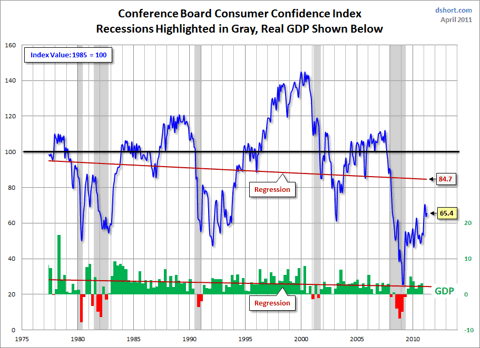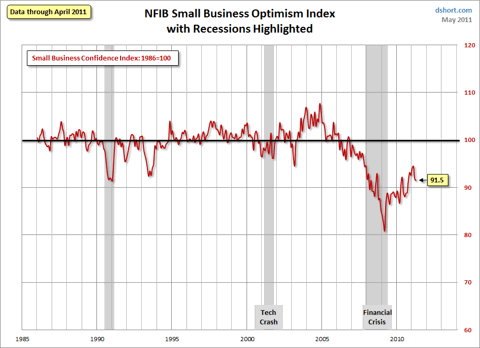May 27th, 2011 (0) Posted By Sochea
WASHINGTON (Reuters) – The economy remained sluggish early in the second quarter as high gasoline prices crimped consumer spending and bad weather helped push pending home sales to a seven-month low in April.
Consumer spending increased 0.4 percent for a 10th straight month of gains, the Commerce Department said on Friday, after rising 0.5 percent in March.
But prices rose 0.3 percent, leaving spending up just 0.1 percent and incomes stagnant when adjusted for inflation.
Tornadoes and floods, which lashed parts of the country last month, were blamed in part for an 11.6 percent plunge in contracts to buy previously owned homes last month.
“We see the soft patch of the first quarter bleeding, at least, into the first half of the second quarter,” said Robert Dye, senior economist at PNC Financial Services in Pittsburgh.
“We will see again a consumer that can keep pace with the economy, but cannot drive the economy forward.”
Recent data including retail sales and industrial output have been soft, prompting economists to lower their growth forecasts for the second quarter. Further cuts are likely next week should May auto sales come in very weak. Second-quarter gross domestic product forecasts are currently ranging between a 2.5 percent and 3 percent rate.
The government reported on Thursday that consumer spending — which accounts for about 70 percent of U.S. economic activity — grew at a tepid 2.2 percent annual rate in the first quarter, slowing from a 4 percent clip in the final three months of 2010.
That contributed to holding back overall economic growth to a 1.8 percent pace during the quarter after a 3.1 percent rate in the October-December period.
With much of the slowdown attributed to what policymakers see as temporary factors, such as high commodity prices and supply chain disruptions because of the earthquake in Japan, the Federal Reserve is not expected to worry too much about the pace of recovery.
The central bank is expected to keep its ultra-easy monetary stance after it wraps up its $600 billion government bond-buying program in June before it start looking at ways to withdraw some of the stimulus it has lent the economy.
INCOMES STAGNANT
U.S. financial markets were little moved on the data. Stocks rose, while government debt prices fell modestly. The dollar fell against a basket of currencies.
The high gasoline prices swallowed almost all the increase in incomes from U.S. tax cuts enacted in December.
Economists worry that stagnant incomes — which have failed to keep up with inflation — will continue to impede spending even though prices at the fuel pump are starting to fall.
So far, consumers have resorted to saving less and some are tapping into their savings to maintain spending. Incomes rose 0.4 percent last month, but disposable incomes adjusted for inflation were flat for a second straight month.
Real incomes have not grown this year and the saving rate stayed at a 2-1/2 year low of 4.9 percent in April. According to the Commerce Department’s chief economist, Mark Doms, Americans saved $82 less over the past four months.
“Consumers have dipped into savings in order to make it through this challenging environment,” said Michael Feroli, an economist at JPMorgan in New York.
“Just as consumers used savings to smooth through the energy price spike on the upside, any move to rebuild saving in the wake of easing gas prices could soften the lift to what otherwise should be a very stimulative development.”
The retreating gasoline price helped to lift consumer spirits this month and dial down their inflation expectations.
The final version of the Thomson Reuters/University of Michigan consumer sentiment survey showed sentiment among Americans rose this month to 74.3 from 72.4 in the preliminary May reading.
The survey’s one-year inflation outlook fell to 4.1 percent from 4.4 percent in April, while expectations for the next five years dipped to 2.9 percent from 3.0 percent.
The national price for regular unleaded gasoline prices slipped to $3.90 a gallon in the week through Monday, according to the Energy Information Administration, after peaking just above $4 a gallon early in the month.
This is giving some economists a reason to be optimistic.
“We are optimistic that the recent easing of gas prices — if it continues — will provide a tailwind to consumption in the coming months,” said Joseph LaVorgna, U.S. chief economist at Deutsche Bank in New York.
High gasoline prices pushed up the year-on-year inflation rate to 2.2 percent, the biggest rise in a year, after increasing 1.8 percent in March.
Excluding food and energy, prices increased 1 percent, the largest gain since September, after rising 0.9 percent in March. Fed officials would like this measure close to 2 percent.

 The University of Michigan Consumer Sentiment Index final report for May came in at 74.3, an unexpected improvement over both the April final of 69.8 and the May preliminary reading of 72.4. The Briefing.comconsensus expectation had been for 72.4 and Briefing.com's own forecast was for 72.6. The rise in gasoline prices, often a drag on sentiment, hasn't taken a toll on the mood of the consumer.
The University of Michigan Consumer Sentiment Index final report for May came in at 74.3, an unexpected improvement over both the April final of 69.8 and the May preliminary reading of 72.4. The Briefing.comconsensus expectation had been for 72.4 and Briefing.com's own forecast was for 72.6. The rise in gasoline prices, often a drag on sentiment, hasn't taken a toll on the mood of the consumer. To put today's report into the larger historical context since its beginning in 1978, consumer sentiment is about 14% below the average reading (arithmetic mean), 12% below the geometric mean, and 15% below the regression line on the chart above. The current index level is at the 23rd percentile of the 401 monthly data points in this series
To put today's report into the larger historical context since its beginning in 1978, consumer sentiment is about 14% below the average reading (arithmetic mean), 12% below the geometric mean, and 15% below the regression line on the chart above. The current index level is at the 23rd percentile of the 401 monthly data points in this series The Michigan average over since its inception is 86. During non-recessionary years the average is 88.9. The average during the five recessions is 69.3.For the sake of comparison here is a chart of the Conference Board's Consumer Confidence Index (monthly update here). The Conference Board Index is the more volatile of the two, but the general pattern and trend are remarkably similar to the Michigan Index
The Michigan average over since its inception is 86. During non-recessionary years the average is 88.9. The average during the five recessions is 69.3.For the sake of comparison here is a chart of the Conference Board's Consumer Confidence Index (monthly update here). The Conference Board Index is the more volatile of the two, but the general pattern and trend are remarkably similar to the Michigan Index



